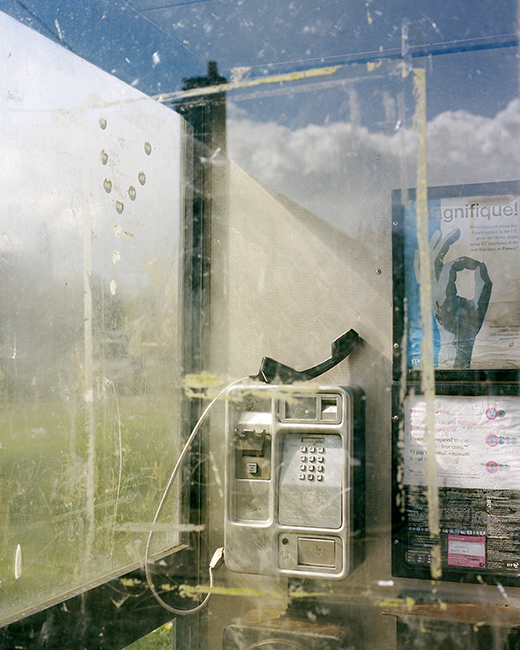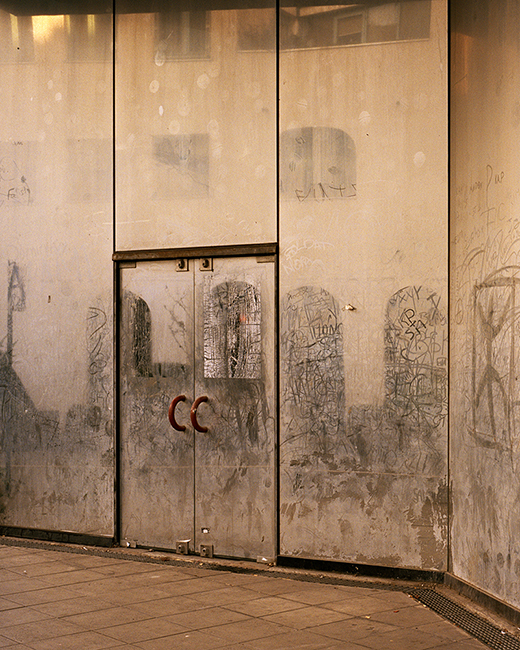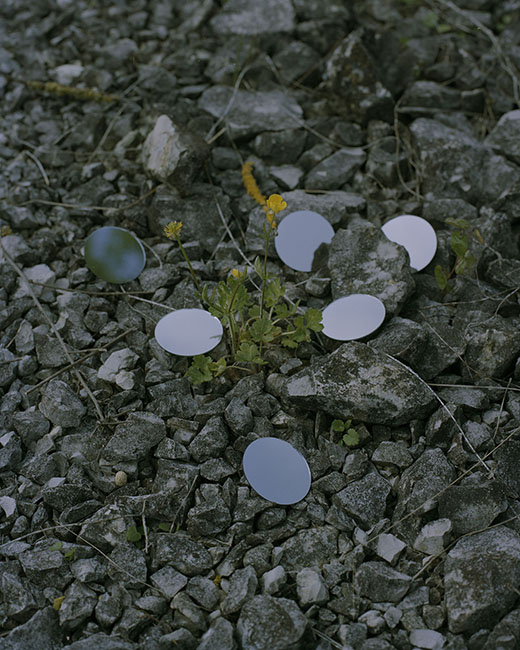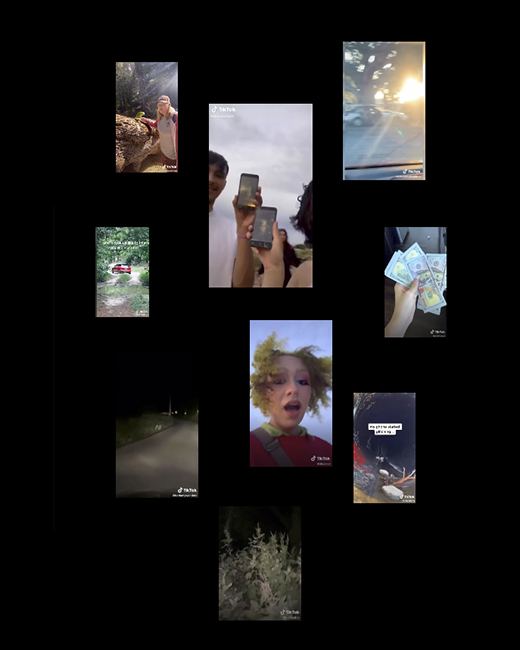
Emily Graham
Emily Graham on Dreams, Fantasies, and Obsessions
TBILISI PHOTO FESTIVAL X FUTURES
Interview by René Mariam Nadareishvili
R. N.: In the project the Blindest Man you have travelled with the treasure hunters, shared experiences of seeking and failure. It must have been a fascinating journey, and you’ve spent a significant amount of time around searchers. How much did you immerse yourself into the process?
E. G.: I suppose, I can start by saying, at first, I actually didn't think that I would spend time with the treasure hunters, and that was something that kind of evolved through the process. So, in the beginning, my photographic practice is often based on walking and making photographs. I was doing that a lot at the time. And so, I started to think about the walks that I would go on as a kind of scavenger hunt because I was thinking about how much when the thing that I saw during walking was influenced by what was in my mind. So, often I would read fiction about the places that I was going to photograph. And I was thinking about what was in my mind in terms of expectations on the place, on what I was drawn to photographing. So, that was my kind of starting point. I thought unsolved treasure hunts might be an interesting framework to work with. I came across this treasure hunt in France that claimed to be the longest-running unsolved treasure hunt and was totally fascinated with it. And the more I dug into the details, the more they were obscure because a lot of those were manifested on online forums, where people would post their solutions or failed solutions. I thought about using those as a kind of route for making photographs. At first, I travelled to France and followed people's routes, people's failed routes. I would read about the stories surrounding the hunt, which are totally fascinating because they were riddled with false starts, dead ends. There were myths built around the treasure and they were self-sustaining. There was one that on the night the treasure was buried, they also came across someone with a dog named Dracula. So, there was a kind of sub-search in France with someone who had a dog named Dracula. And there's also a story about someone blowing up a Church in the process of looking for the treasure. I think this frustration of not being able to find what you're looking for was super fascinating to me. And I realized the more I looked into it, the more I wanted to find out about it. So, at that point I started to kind of engage with the treasure hunters and find out about their individual approaches and stories. And that also became a kind of guide for me. I was always interested in the treasure hunt as a kind of metaphor. I was more interested in the kind of psychological state of unrealized dreams and fantasies. The first person I met was someone that had quite strong beliefs that the hunt was a fraud because his solutions hadn't mapped out, they haven't led to any treasure, and he was subsequently suing the family of the dead author. Also, there's an Association of Treasure Hunters, and that was set up by some committed searchers. And that is an online forum. They're a certified association, they meet once a year in a different location. It's a really interesting event because it's part of social activity. People stay up late every night discussing destinations, arguing about the different approaches. That is a kind of interesting dance because it's sharing their submissions, but not sharing the details of the destination, that kind of the exact location. So, there's an atmosphere of secrecy and sharing.

Emily Graham. The phonebooth, The Blindest Man
R. N.: Your journey sounds really enchanting and also, overwhelming because you interacted with many different people and had diverse experiences. How did your concept change during the process?
E. G.: I would meet people at the gathering of the association and then later I would go meet them at their houses, which were all over France. And then it was quite important to me to spend time with them on their own, I recorded interviews. In the end, I haven't used any of those interviews. I mean, in the book. But those interviews entirely guided how I would photograph a person, what I would photograph. So, for example, one person has a spiritual reading of the quest. She thinks the puzzle is not a guide to something material, but a guide to speak to and to interpret the world. She was a super, super interesting character that I spent a good couple of days with. And then another man, who sees himself as a protagonist in the literary history of the treasure hunt, always being on the cusp of finding it and how that took him away from his time with family and friends. And the person I mentioned to you, he's raised the court case, and he's so convinced of his beliefs. So, my plan definitely changed as I got more interested, more fascinated with the kind of myth. That was certainly a temptation to try and tell that story through documentary mode. There's also this kind of connection to the photographic act, this pursuit of trying to kind of capture the worlds in photographs.

Emily Graham. Out of Paris, The Blindest Man
R. N.: Another project of yours, the Palace also takes place in France. It's a visual representation of the semiotics of warning signs and symbols. How did you get interested in this topic? There is kind of a multidisciplinary approach towards the phenomena. Did you conduct any background research in semiotics?
E. G.: To be honest, it's not a complete project. That actually came out of the commission from the Wellcome Trust, which is a kind of arts and science organization in the UK. And it was an assignment commission with a writer. So, I worked with Helen Gordon who has just published a book on long-time thinking. The photographs that are on my website, they're made during a particular time that I spent on the location of the Ambra Research site. They're doing a kind of geological research into the landscape with the intention of building that site into underground storage from nuclear waste. And so, they have a research center and a research facility. Well, a component that I was interested in was around the creation of memory. When I was there, Helen and I interviewed some people, who were running the memory program. We spent some time in the facility, they have a kind of museum, where they took some of the different approaches to this kind of memory creation from. They have commissioned various semioticians. I mean, there's a field of nuclear semiotics that has been going since the eighties, which began out of the American Nuclear Waste Program. There are various sides to this. One has been to commission artists to think about different ways in which you can kind of create a message or create something, a communication mode that would last over a period of time. So, they have various documentation on that. There's also a semiotician who has been doing various studies into this. And he has come up with a theory of a kind of praxeological device, which is really fascinating. It's the idea of making something, which communicates a message through humans learning by action. As I said, I don't feel it’s finished yet. It's something I'm still researching, and I want to build into a bigger body of work that, I suppose, starts from the nuclear waste dilemma, but is perhaps more about the semiotics and communication, creation of memory, and long-term thinking, and ancestral thinking.

Emily Graham. Mirrors and pebbles, The Palace, 2019
R. N.: Would you say, you have a methodology that unifies all of your work? Including how you generate the ideas, what stages the projects go through during the process?
E. G.: I don’t tend to set out a proposal. The Blindest Man, I think, is the clearest example of the way in which I made it naturally work, which is to start by walking and making photographs and then seeing what develops from both of them and how it’s influenced by what I'm reading at the time, by what I'm thinking about, how it comes to structure itself. So, for example, there's a body of work I'm working on at the moment, which was shown in part at the Futures exhibition, and which is curated by Marina Paulenka. That body of work follows a similar process as the Blindest Man.
R. N.: Are you willing to share more about your current work?
E. G.: I came across an app called Randonautica, that became viral in 2020. It's basically a random number generator, and it generates a random location. So, you have a radius of like five miles and it randomly generates a destination to go to. It's basically a random number generator, and it generates a random location. So, you have a radius of five miles and it randomly generates a destination to go to. Within the app there is a pseudo-scientific spiritual element whereby you set an "intention" that will influence the generation of the location. It claims to help users enhance their spirituality. Young people film their experiences and post on Tik Tok and a community has generated around this app. It became really popular when a group of young people came across the human remains in a suitcase. There was a kind of gamification of the real world happening through the app, and this incident created a kind of shock that only served to make the app more popular.
I was interested in utilising this app as both a way of looking at how young people were kind of experiencing their surroundings and documenting that, and in how these journeys were a way of looking for meaning within the everyday. I started using this app as a framework for making photographs myself - using it to set out journeys on which to photograph. I have been working to combine my own photographs with these video constellations of fragments of people's Tik Tok videos that I've been making. It’s something I'm still working on and still thinking about at the moment.

Cover image: Emily Graham. Untitled, Echo, (2020-)
This series of articles are published in order to create new artistic opportunities for the Futures Talents - the photographers that are part of Futures platform. In 2020 Tbilisi Photo Festival has joined the FUTURES - Europe based photography platform co-funded by the Creative Europe program of the European Union. Futures bring together the global photography community to support and nurture the professional development of emerging artists across the world. The project implemented in partnership with Tbilisi Photography & Multimedia Museum.